The Psychology of Grief: The 4 Stages Explained

On one hand, it is a complex and painful maelstrom of thoughts and emotions triggered by the loss of someone precious to an individual.
On the other hand, it is a natural and positive healing process that plays an essential role in helping us work through and let go of the often unavoidable trauma of loss.
In this article, you’ll learn how to resolve this contradiction and understand that while grief is challenging and complex, it is ultimately straightforward to understand and navigate.
Before you continue reading, we thought you might like to download our three Grief Exercises [PDF] for free . These science-based tools will help you move yourself or others through grief in a compassionate way.

This Article Contains:
What is grief 5 symptoms & common emotions, grief and loss theories: 4 models & cycles, how does grief affect the brain and body, grief vs complicated grief, helpful resources from positivepsychology.com, a take-home message.
Put in the simplest terms, grief is an intense emotional experience triggered by a loss. Grief is most commonly experienced in the context of death, such as the death of someone close to the grieving individual or the individual themselves in the process of dying.
However, loss comes in many forms, and grief can also be experienced following the loss of a relationship, a job, faith, significant material assets, and so on.
It’s appropriate that the word ‘grief’ has its roots in the Latin ‘gravis,’ which roughly translates to ‘a heavy burden.’ Grief emerges from the heavy burden of emotions triggered by the loss (Dunne, 2004).
Before you read any further, it’s important to bear in mind that grief is not a clinical condition. Assuming that your client is experiencing a clinical issue can be a dangerous approach, as it may alienate them during a time when they are already feeling isolated and make them withdraw or feel shame about disclosing experiences that are completely healthy.
After all, everyone is likely to experience grief during their lifetime. Grief can also present differently between individuals. Your client’s experience will be shaped by their personal expectations and beliefs about the nature of grief, which are themselves shaped by the unique combination of your client’s personality, faith, culture, and life history.
With that in mind, several symptoms that are common among grieving individuals can also characterize grief. We can group these symptoms into five different categories: physical, cognitive, emotional, interpersonal, and lifestyle (Stroebe & Schut, 1998).
Physical symptoms
These are symptoms that have a physiological effect on the grieving individual. They resemble the physical symptoms of depression and include loss of appetite, difficulty sleeping, fatigue and loss of energy, physical pains (which may be psychosomatic), and a suppressed immune system. More acute physical symptoms may be episodes of weeping, wailing, or intense physical agitation.
Cognitive symptoms
Grief can also influence how an individual thinks and perceives their world. For example, the grieving individual might feel a sense of dissociation and distance from reality, linked to feelings of disbelief concerning the loss. They may also experience confusion, poor memory, and lack of focus.
Emotional symptoms
The most typical symptom of grief is negative emotion. The spectrum of possible emotions can be diverse, including depression, guilt, anger, hostility, anxiety, despair, hopelessness, and feelings of isolation. These emotions rarely occur simultaneously and may appear in connected but distinct phases.
Interpersonal symptoms
The effects of grief can spill over into the grieving individual’s relationships with others. For example, grief is often accompanied by social withdrawal and feelings of distance or resentment toward relationships that may have been healthy before.
Lifestyle symptoms
Finally, symptoms of grief can also be observed in lifestyle changes, such as failing to perform daily routines and self-care and resigning from activities that the grieving individual previously found stimulating.
The role of anger while grieving
It may surprise you to see anger mentioned as one of the possible symptoms of grief. Anger is essentially our brain protesting against something we are experiencing that is perceived as unjust and frustrating.
A grieving individual is beset by a number of confusing and stressful experiences caused by a loss that is often perceived as unfair and frustratingly uncontrollable. In this sense, anger and grief go hand in hand, as anger provides a way of expressing the powerlessness and despair experienced by the grieving individual (Rueth & Hall, 1999).
The consequence of this is that it may seem as though the individual is hostile or bitter toward surrounding people or themselves. But it is important to look past this and recognize that anger may be a necessary expression of the deeper psychological stress of grief.
How long does grief last?
Fundamentally, the duration of grief depends on the nature of what was lost. It stands to reason that the more intensely your client is affected by this loss, the longer it will take them to heal. For example, grief following the loss of a beloved pet or a valued job is no less legitimate than grief following the loss of a loved one, but it is likely to be less intense and, therefore, shorter.
To understand the processing of an immense loss, various theories have been modeled. Below are four main theories.
Grief response model: The 5 stages of grief
A popular theoretical approach is to structure grief as a progression through a series of stages that follow a systematic and often linear order.
Kübler-Ross (1969) proposed a five-stage theory based on the experiences of terminally ill individuals coming to terms with their death. Here, grief begins with denial, in which the grieving individual is not merely unable to process their loss, but actively unwilling, and they will try in vain to avoid acknowledging what has happened.
This leads to the next stage, in which failure to deny the loss forces the individual to face it, causing acute feelings of frustration and bitterness that manifest as anger and hostility.
When anger does not provide comfort, grief then evolves into attempts to bargain, characterized by the grieving individual seeking means to reverse the loss in return for a sacrifice, often involving appeals to religion or spirituality. This often does not succeed, and the grieving individual may increasingly ruminate over the loss and experience feelings of guilt or despair as they consider how it could have been avoided.
This leads to depression, as the individual resigns to their fate while still fundamentally existing in a state of conflict with their loss. The silver lining of this otherwise bleak stage is that the individual no longer attempts to avoid accepting their grief (through denial, bargaining, etc.), which eventually leads to true acceptance and letting go of their loss, or at least reaching a state of amnesty.
An alternative theoretical perspective is referred to as ‘grief work.’ Grief work assumes that an individual will not be able to overcome their grief unless they actively try to let go of what was lost. Once they do this, they can take the energy that was invested into despair and use it constructively to adapt to any changes that have happened because of the loss (Lindemann, 1944).
Worden (1982) provided a formal description of this process of grief work in the form of a series of tasks that the grieving individual needs to work through in sequence in order to accept their loss and move on.
The first task is to accept that the loss has actually occurred and move past any attempt at denial. The second task is to allow the pain of grief to be experienced without attempting to suppress or redirect this pain elsewhere.
The third task is to accept that life no longer features whatever was lost and begin to adapt to this new life. The final task is to take the energy that was invested into the relationship that was lost and reinvest it into a new or existing relationship.
The grief cycle
Not all theoretical approaches to grief are structured as a linear progression through a series of stages. Some prefer to represent grief as a cyclical process, where the grieving individual repeats phases multiple times on a gradual journey to recovery.
The dual process model of grief (Stroebe & Schut, 1999) is an example of a cyclical model, in which the grieving individual oscillates between two processes of grief. The first, loss orientation, involves acknowledging the loss and experiencing associated pain as a necessary process of emotional healing.
The second, restoration orientation, involves stepping away from emotion and dealing with the more practical lifestyle issues caused by what was lost. These two processes cycle repeatedly, gradually healing the grieving individual, until they can move on from their loss.
The grief curve
The theories described above may be unnecessarily complex for your practice or may not be easily communicated to your client. If this is the case, a much simpler way of thinking about grief is the idea of the grief curve. This concept was originally developed to complement the Kübler-Ross (1969) stage theory described above, but it can be used independently of a specific theory.
The grief curve is a simple representation of grief as a U-shaped curve, moving from high morale and energy, to low morale and hopelessness, and then back to high morale and energy. The high point at the beginning of the curve is characterized by the almost manic energy of denial, shock, and anger.
The low point in the middle of the curve is the depth of despair and depression after the initial investment of energy proves futile. Finally, the high point at the end of the curve is the restoration of energy and morale as the loss is accepted and life resumes.
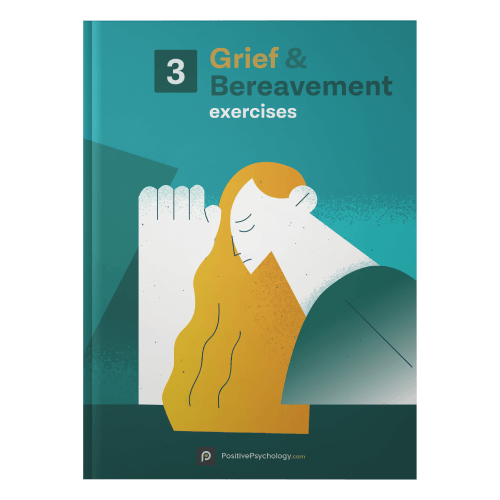
Download 3 Grief & Bereavement Exercises (PDF)
These detailed, science-based exercises will equip you or your clients with tools to process grief and move forward after experiencing loss.
Download 3 Free Grief Tools Pack (PDF)
By filling out your name and email address below.
- Email Address *
- Your Expertise * Your expertise Therapy Coaching Education Counseling Business Healthcare Other
- Comments This field is for validation purposes and should be left unchanged.
The severe emotional pain experienced in grief can have a profound effect on the brain and body as well. You may have noted this earlier when potential physical symptoms of grief were described.
This is a stark reminder of the connection between our mental and physical health, and it can be useful to have a sense of the latter when working with your client on the former.
Grief is associated with noticeable changes in brain activity detectable via neuroimaging. These changes are seen in a variety of brain regions linked to different aspects of the grief experience.
When exposed to words related to their loss, grieving individuals exhibited increased activity in the amygdala, an ancient region of the brain strongly implicated in negative emotion and fear. Regions associated with rumination also show increased activity, similar to individuals with clinical depression (Freed, Yanagihara, Hirsch, & Mann, 2009; O’Connor, 2019).
Another study found that recovery from grief was slower in grieving individuals who had higher activity in the nucleus accumbens, a region of the brain associated with the pursuit of desires, which likely reflects ongoing activity to seek out what was lost (O’Connor et al., 2008).
This is a cross-section of grief in the brain, but grief also has longer term effects. Individuals who experience severe long-term grief exhibit greater cognitive decline , which is an early indicator of serious acquired neurodegenerative conditions, such as Alzheimer’s disease (O’Connor, 2019).
Use this to empower your client, by impressing upon them how important their efforts to overcome their grief are and that their grief is legitimized by clear physical fingerprints in their brain.
Terms like heartbreak are used colloquially in the description of grief, and clients may express the subjective feeling of pain in their heart accompanying their despair and anxiety.
But this feeling may be more than subjective. ‘Broken-heart phenomenon’ has been the topic of serious scientific study. This phenomenon refers to the increased risk of mortality following the loss of a loved one and, in particular, the risk of death from cardiovascular disease.
In a large-scale survey of widowers, the risk of coronary heart disease was twice as high in the six months following their loss. Another study suggested this increased risk of heart disease was even more significant than the risk associated with smoking (O’Connor, 2019).
The physical stress associated with heartbreak should therefore be taken quite literally. Again, use this as an opportunity to affirm your client’s choices and potentially explore stress management therapies that may help reduce this risk.

However, for some individuals, this process is not so straightforward. The grieving process can become obstructed or set on a trajectory that resembles a downward gradient (as opposed to the U-shaped curve that represents the normal trajectory of grief). This stretches the duration of the grief experience into years and transforms it from a healthy process into a serious mental health issue.
The term ‘ complicated grief’ is used to differentiate this form of grief from normal grieving.
Complicated grief represents an issue that warrants a clinical approach, as the grieving individual needs professional intervention to avoid spiraling into deeper trauma. In other words, if normal grief is a medicine, complicated grief is a serious allergic reaction to that medicine that requires medical assistance.
Can grief cause depression?
The fatigue and hopelessness experienced by an individual struggling with long-term complicated grief may be a risk factor for comorbid depression, which may then further complicate their already complicated grief.
However, while complicated grief and depression have a lot in common, it is nevertheless important to view complicated grief as a distinct condition.
Where depression is characterized by a sense of self-loathing, this is not seen in grief, and where depression is a generalized loss of interest in life, grief is characterized by an obsessive but painful interest in returning what was lost.
As a result, treating complicated grief should be seen as the priority and not confused with treating any accompanying depression (Shear, 2012).
Can grief and loss lead to anxiety?
Anxiety is a common emotional symptom of grief, characterized by feelings of separation anxiety , feeling overwhelmed, and social anxiety. An individual with complicated grief may experience significant trauma from the long-term experience of this anxiety, and this trauma may be sufficient to trigger an anxiety disorder.
Unfortunately, it can be difficult to identify what anxiety is because of grief and what might be due to an acquired disorder. If you are concerned about your client’s anxiety, work with them to see whether they could meet the criteria of panic disorder or generalized anxiety disorder. This may help you avoid losing track of your client’s grief amid other conditions they may be experiencing.
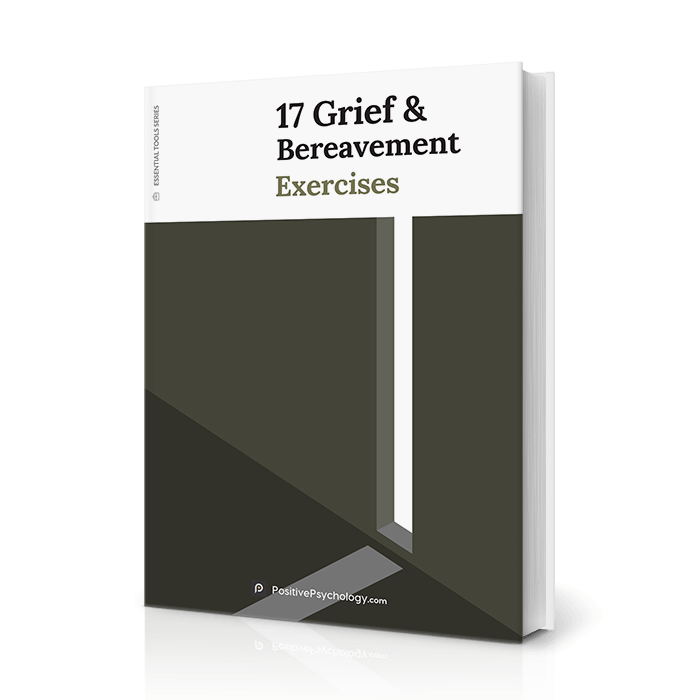
17 Exercises For Grief & Bereavement
Apply these 17 Grief & Bereavement Exercises [PDF] to help others process difficult emotions, leverage self-compassion, and find balance following painful loss.
Created by Experts. 100% Science-based.
As part of our Positive Psychology Toolkit© , for which you can purchase an annual subscription, we offer over 400 tools and exercises, plus access to our community of professionals.
Some of our tools that can assist with grief are mentioned below.
- Acknowledging loss can be difficult, especially if the loss is the death of a loved one. It can be helpful to approach acknowledging this loss through a structured and positive framework, which is exactly what The Life Certificate exercise provides.
- Experiencing the pain of loss is a necessary part of grieving. Fostering acceptance of these emotions may help your client cope with this challenging aspect of grieving. They may benefit from practicing our Acceptance of Emotions Meditation .
- For a more striking demonstration, they may find the Practicing Acceptance With Ice Cubes exercise useful.
- Finally, they may benefit from using our worksheet on Identifying Emotional Avoidance Strategies .
Another resource that is well worth mentioning is our article Coping With Grief for Children .
If you’re looking for more science-based ways to help others move through grief in a compassionate way, this collection contains 17 validated grief and bereavement exercises . Use them to help others find balance as they attempt to make sense of a life that has been irrevocably changed.
Grief has a variety of typical symptoms, but these symptoms may appear in a different combination or intensity between individuals.
Grief is a normal and healthy process, but can be associated with negative changes to physical health. Be vigilant for complicated grief, which poses a serious mental health concern.
There are a number of theoretical approaches to understanding grief and complicated grief. Reflect on the theories you’ve read about here, and think about which (if any) you identify with or recognize in your client.
We hope you enjoyed reading this article. Don’t forget to download our three Grief Exercises [PDF] for free .
- Dunne, K. (2004). Grief and its manifestations. Nursing Standard, 18 (45), 45–51.
- Freed, P. J., Yanagihara, T. K., Hirsch, J., & Mann, J. J. (2009). Neural mechanisms of grief regulation. Biological Psychiatry , 66 (1), 33–40.
- Kübler-Ross, E. (1969). On death and dying . Simon and Schuster.
- Lindemann, E. (1944). Symptomatology and management of acute grief. American Journal of Psychiatry , 101 (2), 141–148.
- O’Connor, M. F., Wellisch, D. K., Stanton, A. L., Eisenberger, N. I., Irwin, M. R., & Lieberman, M. D. (2008). Craving love? Enduring grief activates brain’s reward center. NeuroImage , 42 (2), 969–972.
- O’Connor, M. F. (2019). Grief: A brief history of research on how body, mind, and brain adapt. Psychosomatic Medicine , 81 (8), 731–738.
- Rueth, T. W., & Hall, S. E. (1999). Dealing with the anger and hostility of those who grieve. The American Journal of Hospice & Palliative Care , 16 (6), 743–746.
- Shear, M. K. (2012). Grief and mourning gone awry: Pathway and course of complicated grief. Dialogues in Clinical Neuroscience , 14 (2), 119–128.
- Stroebe, M., & Schut, H. (1998). Culture and grief. Bereavement Care , 17 (1), 7–11.
- Stroebe, M., & Schut, H. (1999). The dual process model of coping with bereavement: Rationale and description. Death Studies , 23 (3), 197–224.
- Worden, W. (1982). Grief counseling and grief therapy: A handbook for the mental health practitioner . Springer.
Share this article:
Article feedback
What our readers think.
This is very insightful. I work in behavioral health and addiction treatment and this topic is important in recovery. Many people do not understand grief or how to cope and heal from it. In turn, this often leads to serious mental health and behavioral issues. I’ve learned through my work that grief is often the result of deep rooted trauma, which manifests as addiction. Thank you for your efforts on educating people to the importance of understanding grief.
I received an email from Seph with resources, articles on 13 Types of Grief, and the 10 Grief Counseling Therapy Techniques. Thank you, I will be trying them out. I am open to any other resources.
Dear Dr. Celestine, I run a program for the VA, a weekly Zoom meeting group for Vietnam Veterans with PTSD. For this aging population William’s article is very relevant. Unfortunately they are not eager to read longer partly-scientific articles, however beneficial or relevant, but prefer talks, videos, etc. Do you know of any videos, TEDtalks, or other presentations which provide (even parts of) this information?
Thank you, Jon
Thank you, William. I am the founder and senior consultant of Optimum Practice Solutions. My focus is on providing organizational management tools and techniques as well as other solutions to support the veterinary and medical professions.
I write educational articles 3-4 times a month which are sent to my subscriber list via email. With a high rate of mental illness and suicide in veterinary medicine and the healthcare profession, I’d like to reprint this article with you as a Guest in one of my upcoming articles. You’ll find me on LinkedIn https://www.linkedin.com/in/marylemalloy/
Let me know as soon as possible if I have your permission.
Thanks for your interest. Could you please send a few details about your organization, the purpose for which you’d like to republish this article, and the contact for your publishing manager via our contact form here , and we will be in touch 🙂
– Nicole | Community Manager
can’t seem to download 3 free PDF exercises. It keeps taking me to buy 17 grief exercises, which I already bought.
Hi Christi,
Sorry for the confusion. The 3 PDF exercises will be automatically sent to your email after entering your address, so please check your inbox (and your junk if they are not there).
Let me know if this helps.
Thank you so much for the wonderful , detailed information. These resources help in supporting the clients. These kind of resources help the therapist to connect with the clients and help them in their journey.
Let us know your thoughts Cancel reply
Your email address will not be published.
Save my name, email, and website in this browser for the next time I comment.
Related articles
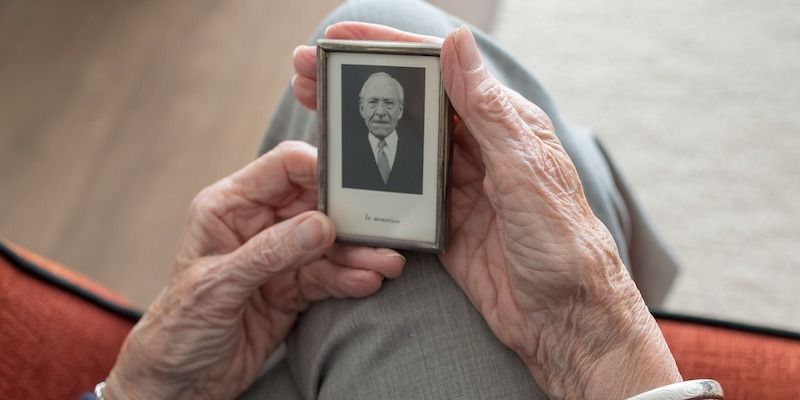
Reminiscence Therapy vs. Life Review Therapy: A Quick Guide
Remembering is a powerful skill. It has the potential to help us revisit the positive emotions of our past, while improving our connections with ourselves [...]

Breakup Therapy: How to Help Clients Cope With Grief
Everyone who has experienced love has, most likely, faced a painful breakup. Ongoing research is beginning to recognize that the feelings associated with losing a [...]

How to Treat Complicated Grief in Therapy: 12 Examples
Each grief experience is unique, yet we share the need to have it witnessed without someone attempting to lessen it or find ways to reframe [...]
Read other articles by their category
- Body & Brain (49)
- Coaching & Application (58)
- Compassion (25)
- Counseling (51)
- Emotional Intelligence (23)
- Gratitude (18)
- Grief & Bereavement (21)
- Happiness & SWB (40)
- Meaning & Values (26)
- Meditation (20)
- Mindfulness (44)
- Motivation & Goals (45)
- Optimism & Mindset (34)
- Positive CBT (29)
- Positive Communication (20)
- Positive Education (47)
- Positive Emotions (32)
- Positive Leadership (18)
- Positive Parenting (15)
- Positive Psychology (33)
- Positive Workplace (37)
- Productivity (17)
- Relationships (42)
- Resilience & Coping (37)
- Self Awareness (21)
- Self Esteem (38)
- Strengths & Virtues (32)
- Stress & Burnout Prevention (34)
- Theory & Books (46)
- Therapy Exercises (37)
- Types of Therapy (63)

- Email This field is for validation purposes and should be left unchanged.

- Introduction
- Understanding Grief
- People Grieve Differently
- The Brain Fog of Grief
- The Vocabulary of Grief
- Grievers Don’t Need to be Fixed
- Misconceptions About Grief
- There Are No Orderly and Predictable Stages In Grief
- When Caring People Say Dumb Things When You’re Grieving
- What to Say to Others When You’re Grieving
- The Impact of Who you Lost and How you Lost Them
- Heavy Grief Days
- The Grief Letter
- Ways to Remember Them
- Permissions for Grievers
- Creating Bright Spots in the Midst of Grief
- Why Are Many Grievers Not Comfortable Crying In Front of Others?
- Why Grievers Don’t Need to Be Strong
- Do I Just Need Time to Heal From Grief?
- Why Do Grieving People Get the Message They Shouldn’t Be Sad?
- Is Staying Busy Good for Grief?
- The Isolation of Grief
- Can You Fill the Void Left by the Death of Loved One?
- How Long Does the Pain of Grief Last?
- How Do You Get Over Grief?
- I Don’t Want to Forget My Loved One Who Died
- Relationships Change After Loss
- Why Don’t Friends and Family Understand Your Grief?
- How to Tell Others What You Need in Your Grief
- Grief Can Cause You to Re-evaluate Relationships
- I Lost My Spouse and My Friends
All the Phases in the Grief Journey
I’m Grieving and Just Barely Surviving
Why Do I Feel Like I Am Just Existing in My Grief?
When Will I Be Ready for Grief Counseling?
Can You Heal Your Grief?
Living Again After Losing a Loved One
- How Grief Affects Mental Health
- Grief & Depression
- How Trauma Affects Your Grief
- Co-Dependency and Grief
- Should I take medication for my grief?
- The Uniqueness of Grieving A Suicide
- Suicide Shock: I Can’t Believe They Did It
- Feeling Blame and Shame After a Suicide
- The Abandonment of Suicide
- The Stigma of Suicide
- Interview with widow who lost two husbands by suicide
- Losing Your Husband to Suicide
- What To Do With Your Loved One’s Belongings After They Die
- No Cost Financial Coaching & Planning for Widows: Chris Bentley
- Hope When Shattered By Grief
- Answers to Your Questions About Grief
- Is Being Angry at God a Sin After My Loved One Died?
- Where Did My Peace, Joy and Gratitude Go after I lost my loved one?
- Can Grief and Hope Co-Exist?
- Why Does God Heal Some People But Not Others?
- Is Suicide an Unforgivable Sin?
- Why Do I Dislike Platitudes and Bible Verses?
- Why Did God Let My Loved One Die?
- Surviving The Holidays
The Grief Journey
- Foundations Of Grief 14 Episodes
- Misconceptions About Grief 12 Episodes
- Relationships After Loss 5 Episodes
- The Grief Journey 6 Episodes
- Grief & Mental Health 5 Episodes
- Grieving A Suicide 6 Episodes
- Conversations On Grief 4 Episodes
- Grief Talks 1 Episodes
- Questions Grieving Christians Ask 8 Episodes
- Coping With The Holidays and Other Tough Special Days 1 Episodes
Episodes in This Series
Episode 1 : All the Phases in the Grief Journey
Introduction to the grief journey.
This is an introduction to the concept of a grief journey as we look at the common phases even though everyone’s journey is personal and unique.
Healing through grief involves a personal journey. After guiding many individuals and families following the painful losses of loved ones, we know that those who grieve don’t need to be stuck in a state of mourning forever. Grievers have the opportunity to heal as they react, adjust, persevere and ultimately learn to live again. That’s the good news.
The not-so-good news is that your healing journey will not be a walk in the park. There are some realities to the grief journey that you need to know early on. While there are many resources – like this program – to help guide you, you will find that:
- There are no maps or GPS devices to direct your steps, so you may feel lost much of the time.
- The pain of loss will be your faithful and unwelcome companion – unfortunately, pain needs to come along for the ride, which sucks, we know.
- Schedules and timelines simply don’t apply to this journey – each journey is unique and has its own timetable.
- Personal discoveries along the way help you avoid walking in endless circles, and sometimes those discoveries take a while to find and understand.
- Life adjustments are required – life won’t be the same, and adjustments are the rule, not the exception
- Twists, turns and detours are guaranteed and backtracking is to be expected – this is not a linear sort of journey.
And, of course, there are no simple answers, no “get out of jail free” cards, no magic pills, and no one can take the journey in your place. We know this is tough news – but we also know from personal experience, this journey is worthwhile and you can finish it.
Let me end the “not-so-good” news with some better news. You don’t need to travel on your own. Along the way, you will encounter helpful traveling companions – and we encourage you to thoughtfully invite them to join you.
We wish to offer you encouragement, helpful tools, resources, instruction and our personal empathy. In fact, those are the reasons we have created this program.
Your journey doesn’t have to be complete misery. You will find an oasis, here and there, in the emotional deserts you cross. And with honest effort, willingness to lean into the pain and determination to overcome the difficulties that will arise, you will arrive, perhaps a bit battle-weary, to a place of real healing.
You will become stronger as you overcome the challenges before you – but, of course, you won’t grow stronger if you refuse the journey. And you have the freedom to refuse it! Folks say “no” to healing all the time. They refuse the journey by denying the need, avoiding or numbing their pain, and sometimes just pretending to be OK. Unfortunately, denying, avoiding, numbing and pretending simply postpone actual healing.
We want you to know that there are several phases within this journey. We have termed them:
- Surviving – just eking out our days, hour-by-hour, minute-by-minute.
- Existing – returning to some basics of life, but not really living a full life
- Seeking – realizing that just existing is unsatisfactory and looking for a way to actually heal from your loss.
- Healing – making an informed and active approach to grieving with the goal of healing.
- Living Again – adjusting to the differences in your life created by the loss of your loved one – a life that is intentionally restored through self-examination, discovery and determination
We have developed a short video for each of these phases. We’ll drop into each phase with a bit more depth and detail. We will share experiences and revelations we’ve gained along the way. We’ll try to share this hope with you: that despite the overwhelming sense of the difficulty you may be feeling now, there is a more satisfying and meaningful life ahead for you. But you must intentionally and courageously seek it – when you are ready.
You may have already heard from us, or some other source, this phrase: “You don’t get over grief, but you can get through grief.” Healing from loss isn’t like healing from a head cold, recovering from a broken arm or recuperating from surgery. That type of healing often means returning to your life as you knew it before you became unwell.
Recovering through grief means accepting that life is now different. It can’t be the same because you have lost something irreplaceable. The person you lost will remain in your memories, and those memories are part of your essence and your soul.
The 5 phases of your grief journey (as we have introduced them to you) can only be described in broad terms. And that is because, by necessity, your grief journey is completely unique to you and the specific loved one you lost.
You will find that these phases overlap; they may seem endless and murky while you are in them, and the trek through them will require your attention, courage and effort. Neither we nor you can script or plot your journey in advance because you will be writing the story of your recovery as you experience it.

- Healing from loss requires that we go through a journey.
- The journey is individual and cannot be plotted or scripted in advance.
- There will be “phases” in your journey as you recover and heal.
- The journey will prepare you to truly live again.
- Living again will be experienced as a revised version of your life – a new chapter in your story.
STEPPING STONE:
When you are ready, begin to watch the individual videos on the phases of your grief journey – a trek that will lead you to healing and, eventually, living again.
REFLECTION:
The stories of our lives are written on the fly. Tomorrow cannot be written until tomorrow. Just like the weather, the circumstances of our lives are not within our control. But how we choose to respond to the circumstances of our life, allows us to author our personal life story. And the choice to superimpose our responses to what the world gives us moment by moment is called living.
@2023 Grief & Trauma Healing Network, LLC

The Journey Through Grief: The Six Needs of Mourning
by Center for Loss | Dec 21, 2023 | Articles
by Alan D. Wolfelt, Ph.D.
The death of someone loved changes our lives forever. And the movement from the “before” to the “after” is almost always a long, painful journey. From my own experiences with loss as well as those of the thousands of grieving people I have worked with over the years, I have learned that if we are to heal we cannot skirt the outside edges of our grief. Instead, we must journey all through it, sometimes meandering the side roads, sometimes plowing directly into its raw center.
I have also learned that the journey requires mourning. There is an important difference, you see. Grief is what you think and feel on the inside after someone you love dies. Mourning is the outward expression of those thoughts and feelings. To mourn is to be an active participant in our grief journeys. We all grieve when someone we love dies, but if we are to heal, we must also mourn.
There are six “yield signs” you are likely to encounter on your journey through grief—what I call the “reconciliation needs of mourning.” For while your grief journey will be an intensely personal, unique experience, all mourners must yield to this set of basic human needs if they are to heal.
Need 1: Acknowledging the reality of the death
This first need of mourning involves gently confronting the reality that someone you care about will never physically come back into your life again.
Whether the death was sudden or anticipated, acknowledging the full reality of the loss may occur over weeks and months. To survive, you may try to push away the reality of the death at times. You may discover yourself replaying events surrounding the death and confronting memories, both good and bad. This replay is a vital part of this need of mourning. It’s as if each time you talk it out, the event is a little more real.
Remember—this first need of mourning, like the other five that follow, may intermittently require your attention for months. Be patient and compassionate with yourself as you work on each of them.
Need 2: Embracing the pain of the loss
This need of mourning requires us to embrace the pain of our loss—something we naturally don’t want to do. It is easier to avoid, repress or deny the pain of grief than it is to confront it, yet it is in confronting our pain that we learn to reconcile ourselves to it.
You will probably discover that you need to “dose” yourself in embracing your pain. In other words, you cannot (nor should you try to) overload yourself with the hurt all at one time. Sometimes you may need to distract yourself from the pain of death, while at other times you will need to create a safe place to move toward it.
Unfortunately, our culture tends to encourage the denial of pain. If you openly express your feelings of grief, misinformed friends may advise you to “carry on” or “keep your chin up.” If, on the other hand, you remain “strong” and “in control,” you may be congratulated for “doing well” with your grief. Actually, doing well with your grief means becoming well acquainted with your pain.
Need 3: Remembering the person who died
Do you have any kind of relationship with someone when they die? Of course. You have a relationship of memory. Precious memories, dreams reflecting the significance of the relationship and objects that link you to the person who died (such as photos, souvenirs etc.) are examples of some of the things that give testimony to a different form of a continued relationship. This need of mourning involves allowing and encouraging yourself to pursue this relationship.
But some people may try to take your memories away. Trying to be helpful, they encourage you to take down all the photos of the person who died. They tell you to keep busy or even to move out of your house. But in my experience, remembering the past makes hoping for the future possible. Your future will become open to new experiences only to the extent that you embrace the past.
Need 4: Developing a new self-identity
Part of your self-identity comes from the relationships you have with other people. When someone with whom you have a relationship dies, your self-identity, or the way you see yourself, naturally changes.
You may have gone from being a “wife” or “husband” to a “widow” or “widower.” You may have gone from being a “parent” to a “bereaved parent.” The way you define yourself and the way society defines you is changed.
A death often requires you to take on new roles that had been filled by the person who died. After all, someone still has to take out the garbage; someone still has to buy the groceries. You confront your changed identity every time you do something that used to be done by the person who died. This can be very hard work and can leave you feeling very drained.
You may occasionally feel child-like as you struggle with your changing identity. You may feel a temporarily heightened dependence on others as well as feelings of helplessness, frustration, inadequacy and fear.
Many people discover that as they work on this need, they ultimately discover some positive aspects of their changed self-identity. You may develop a renewed confidence in yourself, for example. You may develop a more caring, kind and sensitive part of yourself. You may develop an assertive part of your identity that empowers you to go on living even though you continue to feel a sense of loss.
Need 5: Searching for meaning
When someone you love dies, you naturally question the meaning and purpose of life. You probably will question your philosophy of life and explore religious and spiritual values as you work on this need. You may discover yourself searching for meaning in your continued living as you ask “How?” and “Why” questions.
“How could God let this happen?” “Why did this happen now, in this way?” The death reminds you of your lack of control. It can leave you feeling powerless.
The person who died was a part of you. This death means you mourn a loss not only outside of yourself, but inside of yourself as well. At times, overwhelming sadness and loneliness may be your constant companions. You may feel that when this person died, part of you died with him or her. And now you are faced with finding some meaning in going on with your life even though you may often feel so empty.
This death also calls for you to confront your own spirituality. You may doubt your faith and have spiritual conflicts and questions racing through your head and heart. This is normal and part of your journey toward renewed living.
Need 6: Receiving ongoing support from others
The quality and quantity of understanding support you get during your grief journey will have a major influence on your capacity to heal. You cannot—nor should you try to—do this alone. Drawing on the experiences and encouragement of friends, fellow mourners or professional counselors is not a weakness but a healthy human need. And because mourning is a process that takes place over time, this support must be available months and even years after the death of someone in your life.
Unfortunately, because our society places so much value on the ability to “carry on,” “keep your chin up” and “keep busy,” many mourners are abandoned shortly after the event of the death. “It’s over and done with” and “It’s time to get on with your life” are the types of messages directed at mourners that still dominate. Obviously, these messages encourage you to deny or repress your grief rather than express it.
To be truly helpful, the people in your support system must appreciate the impact this death has had on you. They must understand that in order to heal, you must be allowed—even encouraged—to mourn long after the death. And they must encourage you to see mourning not as an enemy to be vanquished but as a necessity to be experienced as a result of having loved.
Reconciling your grief
You may have heard—indeed you may believe—that your grief journey’s end will come when you resolve, or recover from, your grief. But your journey will never end. People do not “get over” grief.
Reconciliation is a term I find more appropriate for what occurs as the mourner works to integrate the new reality of moving forward in life without the physical presence of the person who died. With reconciliation comes a renewed sense of energy and confidence, an ability to fully acknowledge the reality of the death and a capacity to become reinvolved in the activities of living.
In reconciliation, the sharp, ever-present pain of grief gives rise to a renewed sense of meaning and purpose. Your feeling of loss will not completely disappear, yet they will soften, and the intense pangs of grief will become less frequent. Hope for a continued life will emerge as you are able to make commitments to the future, realizing that the person who died will never be forgotten, yet knowing that your life can and will move forward.
Read the book: “The Journey Through Grief”
Wallet Cards: “The Six Needs of Mourning”

Click to download a Trainings Catalog PDF
News Categories
- COVID-19 Related
- Center for Loss Updates
- Dr. Wolfelt
- In the News
- Publications
- Tour Locations/Dates
- Uncategorized

- Seasonal Sale
- All Authors
- Privacy Policy
- Refund Policy
Item added to your cart
- Open media 1 in modal
The Grief Journey
Couldn't load pickup availability
Dr. Timothy Sumerlin 's The Grief Journey: Finding Peace in All of Life's Losses explores the remarkable restorative healing power of Jesus Christ in times of loss. The Grief Journey focuses on helping participants through their grief recovery journey in a safe and confidential group setting. Rather than avoiding grief, as so many of us are prone to do, this Book helps us take a hard look at the issue in a productive and healing way. I would heartily recommend this practical, faith-affirming program for anyone who has or is currently experiencing the pain of grief due to the loss of a parent, child, spouse or other loved one. – Jim McCraigh, author of The Power of Brokenness – The Language of Healing
Dr. Timothy Sumerlin addresses the sensitive subject of grief by masterfully weaving in his personal journey through losses in his life. This guide helped me see the process of grief in a fresh and innovative way, different from the well-acclaimed Grief Recovery Method. It teaches us how to honor those we have lost while at the same time helping us to deal with unresolved issues. Dr. Sumerlin beautifully combines our faith in Christ with our journey through grief. I highly recommend this handBook to those who struggle through loss and desire God 's hand to guide them through. – Erica S. Kim, author of Finding His Footprints in the Sand: God 's Grace to Women in an Ungracious World. Certified Grief Recovery Specialist.
Shipping & Returns
Shipping destinations:
- We ship worldwide.
Shipping times:
- US orders ( we ship within 1 business day)
- Media Mail: takes 5-8 business days
- Ground Advantage: Takes 2-5 business days
- Priority: Takes 1-3 business days
- International orders take 7-12 business days to be delivered via USPS , DHL , or UPS and we ship within 1 business day.
- Shipping time might vary depending on location, shipment method and time of year
Shipping cost:
- Full price will be displayed on first page of cart on the lower left side of the page.
Email: [email protected]
Phone: (888) 932-4535
- Choosing a selection results in a full page refresh.

The Journey of Grief
Grief can be painful, but we can grow in and through it..
Posted April 20, 2016
- Understanding Grief
- Find a therapist to heal from grief
Review of Grief Is a Journey: Finding Your Path Through Loss . By Dr. Kenneth J. Doka. Atria Books. 304 pp. $26.
All of us, no doubt, will have occasion to grieve. We grieve when a loved one dies, when we get divorced , become disabled, lose a job, break up with a romantic partner, suffer a miscarriage . Grief can be painful, both physically and emotionally. But it can also be beneficial. As we live with a loss, Kenneth Doka reminds us, we can grow in and through grief.
In Grief Is a Journey , Dr. Doka, a professor of Gerontology at the Graduate School of the College of New Rochelle, an ordained Luther minister, and the editor of Omega: Journal of Death and Dying , offers a compassionate view of bereavement as a lifelong journey. Doka examines five “tasks of grief”: acknowledging the loss; coping with pain; managing change; maintaining bonds; and rebuilding faith and/or philosophy . Because each individual is unique, Doka emphasizes, “there is no single right way to experience grief. Nor does grief have a timetable.”
Doka’s advice is based primarily on his work as a bereavement counsellor. Much of it – “avoid lashing out at those around you, driving others away, limiting support” – is commonsensical. And, at times, Doka’s oft-repeated thesis (there is no one-size-fits-all way to grieve) is at war with the architecture of his book. “You cannot compare your loss to the losses of others, or your reactions or responses to those of others,” he writes. After exploring the experiences of many of his clients, however, Doka suggests that “understanding other ways of coping can allow you to cope with loss and to grow from it.”
And, perhaps inevitably, in a “how to book,” Doka’s determination not to be judgmental (he cannot quite bring himself to advise against seeking out psychics) recedes. Expressing feelings, he suggests (citing a Chinese proverb), “leads to momentary pain and long-term relief; suppression leads to momentary relief and long-term pain.”
Happily, several of the recommendations in Grief Is a Journey are quite useful. Doka advises individuals deciding whether to place a physically or cognitively impaired parent or grandparent in a nursing home to address their “anticipatory grief” by indicating with specificity the conditions under which it would be too difficult to continue home care. By creating a virtual dream, containing elements symbolic of the loss (an empty bed, a favorite beach), Doka indicates, mourners can get in touch with emotions and identify unresolved issues. He suggests that those who have lost a spouse or a child consider asking for help before deciding whether and when to dispose of “the stuff of grief” (clothes, toys, tackle boxes). Doka advises grievers to plan holidays, which can be stressful , rather than surrendering decisions to well-meaning others. And mourners, he writes, can design “alternative rituals,” ranging from a memorial service to accommodate grievers for whom distance or role precluded attendance at a funeral, to an annual event to raise funds for a charity in the name of a deceased person.
Most important, Doka, who introduced the concept of “disenfranchised grief” in 1989, reminds us that some losses – the death of an ex-husband or a closeted gay lover; an incarcerated sibling ; persistent infertility ; a loss of religious faith – are not typically recognized or supported by others. Persons with disenfranchised grief, he emphasizes, often suffer in silence, and have little or no context in which to understand or process their reactions.
Grief, Doka repeats, “is not so much about death as it is about loss.” He asks his readers to find some solace, as he has, in the observation of his deceased colleague, Richard Kalish: “Anything you have you can lose; anything you are attached to, you can be separated from; anything you love can be taken away from you. Yet if you really have nothing to lose, you have nothing.”
At best, Dr. Doka adds, mourners will look back and celebrate their life’s journey, which evolved as it did because they responded in healthy ways to the loss(es) they experienced.

Glenn C. Altschuler, Ph.D. , is the Thomas and Dorothy Litwin Professor of American Studies at Cornell University.
- Find a Therapist
- Find a Treatment Center
- Find a Psychiatrist
- Find a Support Group
- Find Online Therapy
- United States
- Brooklyn, NY
- Chicago, IL
- Houston, TX
- Los Angeles, CA
- New York, NY
- Portland, OR
- San Diego, CA
- San Francisco, CA
- Seattle, WA
- Washington, DC
- Asperger's
- Bipolar Disorder
- Chronic Pain
- Eating Disorders
- Passive Aggression
- Personality
- Goal Setting
- Positive Psychology
- Stopping Smoking
- Low Sexual Desire
- Relationships
- Child Development
- Therapy Center NEW
- Diagnosis Dictionary
- Types of Therapy

Understanding what emotional intelligence looks like and the steps needed to improve it could light a path to a more emotionally adept world.
- Emotional Intelligence
- Gaslighting
- Affective Forecasting
- Neuroscience
- Bipolar Disorder
- Therapy Center
- When To See a Therapist
- Types of Therapy
- Best Online Therapy
- Best Couples Therapy
- Best Family Therapy
- Managing Stress
- Sleep and Dreaming
- Understanding Emotions
- Self-Improvement
- Healthy Relationships
- Student Resources
- Personality Types
- Guided Meditations
- Verywell Mind Insights
- 2024 Verywell Mind 25
- Mental Health in the Classroom
- Editorial Process
- Meet Our Review Board
- Crisis Support
- The 5 Stages
How the Five Stages of Grief Can Help Process a Loss
Jodi Clarke, LPC/MHSP is a Licensed Professional Counselor in private practice. She specializes in relationships, anxiety, trauma and grief.
:max_bytes(150000):strip_icc():format(webp)/WIN_20200624_14_59_57_Pro-01f186878e18427b84df787004c95807.jpg)
Amy Morin, LCSW, is a psychotherapist and international bestselling author. Her books, including "13 Things Mentally Strong People Don't Do," have been translated into more than 40 languages. Her TEDx talk, "The Secret of Becoming Mentally Strong," is one of the most viewed talks of all time.
:max_bytes(150000):strip_icc():format(webp)/VW-MIND-Amy-2b338105f1ee493f94d7e333e410fa76.jpg)
- 5 Stages Model
- Additional Models
- How to Help
- Next in The Stages of Grief Guide What to Know About the Denial Stage of Grief
If you or a loved one is dealing with loss , it can be helpful to learn more about the grieving process. Here we share the 5 Stages of Grief, along with a few ways to help someone who is grieving after a death or breakup.
It's important to remember that the grieving process can be complex, and it isn't the same for everyone. These steps may not be followed exactly, or other feelings may surface after you thought you were through the stages of grieving. Allowing room to experience grief in your own way can help you heal after loss.
What Are the 5 Stages of Grief?
The 5 Stages of Grief is a theory developed by psychiatrist Elisabeth Kübler-Ross. It suggests that we go through five distinct stages after the loss of a loved one. These stages are denial, anger, bargaining, depression, and finally acceptance.
In the first stage of the grieving process, denial helps us minimize the overwhelming pain of loss. As we process the reality of our loss, we are also trying to survive emotional pain. It can be hard to believe we have lost an important person in our lives, especially when we may have just spoken with them the previous week or even the previous day.
During this stage in grieving, our reality has shifted completely. It can take our minds time to adjust to our new reality. We reflect on the experiences we've shared with the person we lost, and we might find ourselves wondering how to move forward in life without this person.
This is a lot of information to explore and a lot of painful imagery to process. Denial attempts to slow this process down and take us through it one step at a time, rather than risk the potential of feeling overwhelmed by our emotions.
Denial is not only an attempt to pretend that the loss does not exist. We are also trying to absorb and understand what is happening.
The second stage in grieving is anger . We are trying to adjust to a new reality and are likely experiencing extreme emotional discomfort. There is so much to process that anger may feel like it allows us an emotional outlet.
Keep in mind that anger does not require us to be very vulnerable. However, it may feel more socially acceptable than admitting we are scared. Anger allows us to express emotion with less fear of judgment or rejection.
Anger also tends to be the first thing we feel when starting to release emotions related to loss. This can leave us feeling isolated in our experience. It can also cause us to be perceived as unapproachable by others in moments when we could benefit from comfort, connection, and reassurance.
When coping with loss, it isn't unusual to feel so desperate that you are willing to do anything to alleviate or minimize the pain. During this stage in grieving, you may try to bargain to change the situation, agreeing to do something in return for being relieved of the pain you feel.
When bargaining starts to take place, we often direct our requests to a higher power, or something bigger than us that may be able to influence a different outcome. Bargaining during the grieving process can come in the form of a variety of promises, including:
- "God, if you can heal this person, I will turn my life around."
- "I promise to be better if you will let this person live."
- "I'll never get angry again if you can stop him/her from dying or leaving me."
There is an acute awareness of our humanness in this stage of grieving; when we realize that there is nothing we can do to influence change or create a better end result.
Bargaining comes from a feeling of helplessness and gives us a perceived sense of control over something that feels so out of control. During bargaining, we tend to focus on our personal faults or regrets. We might look back at our interactions with the person we are losing and note all the times we felt disconnected or may have caused them pain.
It is common to recall times when we may have said things we did not mean and wish we could go back and behave differently. We also sometimes make the drastic assumption that if things had played out differently, we would not be in such an emotionally painful place in our lives.
During our experience of processing grief, there comes a time when our imaginations calm down and we slowly start to look at the reality of our present situation. Bargaining no longer feels like an option and we are faced with what is happening.
In this stage of grieving, we start to feel the loss of our loved one more abundantly. Our panic begins to subside, the emotional fog begins to clear, and the loss feels more present and unavoidable.
In those moments, we tend to pull inward as the sadness grows. We might find ourselves retreating, being less sociable, and reaching out less to others about what we are going through. Although this is a very natural stage in the grieving process, dealing with depression after the loss of a loved one can be extremely isolating and one of the most difficult stages.
If you or a loved one are struggling with depression, contact the Substance Abuse and Mental Health Services Administration (SAMHSA) National Helpline at 1-800-662-4357 for information on support and treatment facilities in your area. For more mental health resources, see our National Helpline Database .
The last of the 5 Stages of Grief is acceptance. When we come to a place of acceptance , it is not that we no longer feel the pain of loss. Instead, we are no longer resisting the reality of our situation, and we are not struggling to make it something different.
Sadness and regret can still be present in this phase. But the emotional survival tactics of denial, bargaining, and anger are less likely to be present during this phase of the grieving process.
Click Play to Learn More About the Stages of Grief
This video has been medically reviewed by David Susman, PhD .
How Long Do Grief Stages Last?
There is no specific time period for any of these stages. One person may experience the stages quickly, such as in a matter of weeks, whereas another person may take months or even years to move through the stages of grieving. Whatever time it takes for you to move through these stages is perfectly normal.
As we consider the 5 Stages of Grief, it is important to note that people grieve differently . So, you may or may not go through each of these stages or experience them in order. The lines of the grieving process stages are often blurred. We may also move from one stage to another and possibly back again before fully moving into a new stage.
Your pain is unique to you, your relationship to the person you lost is unique, and the emotional processing can feel different to each person. Take the time you need and remove any expectations of how you should be performing as you work through the grieving process.
Get Advice From The Verywell Mind Podcast
Hosted by therapist Amy Morin, LCSW, this episode of The Verywell Mind Podcast shares how you can stay mentally strong while you cope with grief.
Follow Now : Apple Podcasts / Spotify / Google Podcasts
Additional Grieving Process Models
Although the 5 Stages of Grief developed by Elisabeth Kübler-Ross is considered one of the most easily recognizable models of grief and bereavement, there are other models to be considered as well. Each one seeks to explain how grief may be perceived and processed.
These models can provide greater understanding to people who are hurting over the loss of a loved one. They can also be used by those in healing professions, helping them to provide effective care for grieving people who are seeking informed guidance.
Four Phases of Grief
Legendary psychologist John Bowlby focused his work on researching the emotional attachment between parent and child. From his perspective, early experiences of attachment with important people in our lives, such as caregivers, help to shape our sense of safety, security, and connections.
British psychiatrist Colin Murray Parkes developed a model of grief based on Bowlby's theory of attachment , suggesting there are four phases of mourning when experiencing the loss of a loved one:
- Shock and numbness : Loss in this phase feels impossible to accept. Most closely related to Kübler-Ross's stage of denial, we are overwhelmed when trying to cope with our emotions. Parkes suggests that there is physical distress experienced in this phase as well, which can lead to somatic or physical symptoms .
- Yearning and searching : As we process loss in this phase of grief, we may begin to look for comfort to fill the void our loved one has left. We might do this by reliving memories through pictures and looking for signs from the person to feel connected to them. In this phase, we become very preoccupied with the person we have lost.
- Despair and disorganization : We may find ourselves questioning and feeling angry in this phase. The realization that our loved one is not returning feels real, and we can have a difficult time understanding or finding hope in our future. We may feel a bit aimless during this portion of the grieving process and retreat from others as we process our pain.
- Reorganization and recovery : In this phase, we feel more hopeful that our hearts and minds can be restored. As with Kübler-Ross's acceptance stage, sadness or longing for our loved one doesn't disappear. However, we move toward healing and reconnecting with others for support, finding small ways to reestablish some normalcy in our daily lives.
7-Stage Model of Grief
Some suggest that there are seven stages in grieving instead of only four or five. This more complex model of the grieving process involves experiencing:
- Shock and denial . Whether a loss occurs suddenly or with some advanced notice, it's possible to experience shock. You feel emotionally numb and may deny the loss.
- Pain and guilt . During this stage in grieving, the pain of the loss starts to set in. You may also feel guilty for needing more from family and friends during this emotional time.
- Anger and bargaining . You may lash out at people you love or become angry with yourself. Or you might try to "strike a bargain" with a higher power, asking that the loss be taken away in exchange for something on your part.
- Depression and loneliness . As you reflect on your loss, you may start to feel depressed or lonely . It is in this stage in grieving that you begin to truly realize the reality of your loss.
- The upward turn . You begin to adjust to your new life, and the intensity of the pain you feel from the loss starts to reduce. At this point in the grieving process, you may notice that you feel calmer.
- Reconstruction and working through . This stage in grieving involves taking action to move forward. You begin to reconstruct your new normal, working through any issues created by the loss.
- Acceptance and hope . In this final stage of the grieving process, you begin to accept the loss and feel hope for what tomorrow might bring. It's not that all your other feelings are gone, just more so that you've accepted them and are ready to move on.
How to Help Someone Who Is Grieving
It can be difficult to know what to say or do when someone has experienced loss. We do our best to offer comfort, but sometimes our best efforts can feel inadequate and unhelpful.
Here are a few tips to keep in mind if someone you love is going through the stages in grieving:
- Avoid rescuing or fixing . In an attempt to be helpful, we may offer uplifting, hopeful comments or even humor to try to ease their pain or "fix them." Although the intention is good, this approach can leave people feeling as if their pain is not seen, heard, or valid.
- Don't force it . We may want so badly to help and for the person to feel better, so we believe that nudging them to talk and process their emotions before they're truly ready will help them faster. This is not necessarily true and can actually be an obstacle to their healing.
- Make yourself accessible . Offer space for people to grieve. This lets the person know we're available when they're ready. We can invite them to talk with us but remember to provide understanding and validation if they are not ready just yet. Remind them that you're there and not to hesitate to come to you.

Get Help Now
We've tried, tested, and written unbiased reviews of the best online therapy programs including Talkspace, Betterhelp, and Regain. Find out which option is the best for you.
Resources for People in Stages of Grieving
Several organizations provide information or assistance for people going through the grieving process. Regardless of where you are in the stages in grieving, you may find help via entities such as:
- AARP , for articles on grief and loss
- Grief.com , which covers all types of grief, also providing grief workshops and access to free resources
- HOPE for Bereaved , for anyone who has experienced loss through death
- Hospice Foundation of America , grief support before, during, and after a loved one's death
- OptionB , for people who want to bounce back after a painful experience
- The Compassionate Friends , help for people who've lost a child
It is important to remember that everyone copes with loss differently. While you may experience all five stages of grief, you might also find that it is difficult to classify your feelings into any one of the stages. Have patience with yourself and your feelings in dealing with loss.
Allow yourself time to process all your emotions, and when you are ready to speak about your experiences with loved ones or a healthcare professional, do so. If you are supporting someone who has lost a loved one, such as a spouse or sibling , remember that you don't need to do anything specific. Simply allow them room to talk when they are ready.
University of Rochester Medical Center. Grief and loss: The process of healing .
Newman L. Elisabeth Kübler-Ross . BMJ . 2004;329(7466):627.
Stroebe M, Schut H, Boerner K. Cautioning health-care professionals: Bereaved persons are misguided through the stages of grief . Omega (Westport) . 2017;74(4):455–473. doi:10.1177/0030222817691870
Cassidy J, Jones JD, Shaver PR. Contributions of attachment theory and research: a framework for future research, translation, and policy . Dev Psychopathol . 2013;25(4 Pt 2):1415–1434. doi:10.1017/S0954579413000692
Parkes CM. Bereavement in adult life . BMJ . 1998;316(7134):856–859. doi:10.1136/bmj.316.7134.856
By Jodi Clarke, MA, LPC/MHSP Jodi Clarke, LPC/MHSP is a Licensed Professional Counselor in private practice. She specializes in relationships, anxiety, trauma and grief.
US National Suicide Prevention Lifeline
Call for help: 988
US Crisis Text Line
Text “Hello” to 741-741
International Association for Suicide Prevention
Click to find crisis centers in Africa, Asia, Europe, North America, Oceania and South America
Please consider adding this language to the end of your story:
If you have lost a loved one to suicide, you are not alone. Visit allianceofhope.org to find support resources and learn more about the suicide loss experience.
Subscribe to Free Healing Emails for Mothers

Alliance of Hope for Suicide Loss Survivors
The Alliance of Hope for Suicide Loss Survivors, a 501(c)3 nonprofit, provides healing support for people who have lost loved ones to suicide.

Surviving Suicide Loss > The Grief Journey
The Grief Journey

Introduction
When someone in our life dies by suicide, we suddenly find ourselves on a journey we never planned to take. A journey for which we have no map. A journey with no road signs to guide us.

When a loved one dies by suicide, we are rocked to our core. We lose our equilibrium. We are experiencing the unthinkable. Learn what you can do.

Second Crisis
In the weeks and months following loss, we stumble in the dark – searching for direction and wondering if anything will ever be worthwhile again. Learn the way forward.

Observation
With time, we begin noticing, recollecting, and reflecting – wondering what can be learned from this terrible loss. Learn how our reminiscences help us gain wisdom to shape our future.

As we grieve, we are faced with redefining ourselves and our situation. We recognize that we must revise and replan our lives. Learn more about making the turn.

Reconstruction
Slowly, in incremental steps, we build a new life that is not dominated by loss. We honor the past yet look to the future. Learn what helps us move forward

Working Through
Eventually, we find solid ground, assessing what is and isn’t going to work. Learn how we can we create a life that both honors the past and has new meaning.

Integration
Finally, we have glimpses of a “new normal” and much less emptiness and pain. We are stronger with renewed purpose. Read more about integration of loss.

- Candle Gallery
- View Tributes
- How to Write an Obituary
- Pet Tributes
- Candle Gallery For Pets
- Healing through Art
- Other Ways to Memorialize
- Grief is and grief is not…
- Grieving During the Holidays
- The Mourner’s Bill of Rights
- Helping Children Cope & Deal with Grief
- Death of a Child
- Death of a Spouse
- Death of a Parent
- Death of a Sibling
- Death of a Friend
- Just for Seniors
- Death by Suicide
- Helping Someone Grieve
- Grief Coach
- Death of a Pet
- HealGrief Blog
- Virtual Support
- Actively Moving Forward
- Grief Sensitive Campus Initiative
- Understanding Grief
- Candle Gallery for Pets
- Let’s Talk Death
- Loss project
- Artful Healing
- Before I die…
- On-line Programming
- Local & National Support
- Talk of a Lifetime
- Traditions and Customs for Funerals
- Virtual Support Groups
- For Young Adults
- Confessions of a Syllabus-holic
- Coping with Grief in College
- Testimonials
- Tips for College Students
- Research Findings
- College Student Grief Facts
- Action Steps for Faculty & Staff
- Grief Awareness Spotlights
- Support Your Friend
- The Role of Funeral Homes
- Plan Your Goodbyes at Remembering a Life
- Advanced Care Planning
- Hospice Care
- End-of-Life Checklist
- End of Life Planning Flow Chart
- Living Will
- Estate Planning
- Funeral Planning
- Before I die I want to…

Why Grief is a Journey, Not Just a Step Outside.
- Posted By March 6, 2019

Grief is often described as a journey – how poetic, right? Some days, we wonder why our grief can’t just be as easy as taking a step outside to clear our heads and “get back on the horse”. Remember that grief isn’t just about becoming resilient in the face of loss and quickly finding a new normal, as though we are on a scavenger hunt. Grief is about growing through our loss experiences and continually building our “new normal”.
I feel as though many inspirational quotes can really romanticize grief as a journey by talking about it from the point of what happens when you “get to the top”. Some days, we need inspiration like that. We need to know there’s a “view” to look forward to.
What I will say is that when we talk about grief as a journey, we don’t just think about those “Ohhhh, wow!” moments. We are also talking about the moments when you may feel lost and confused. Grief doesn’t have steps for us to complete or a map for us to follow, so of course we may get a bit lost now and then!
How about when you take a trail you thought would get you to one place, but you really just end up where you’ve already been? These may be the times that grief kind of sneaks up on you and you think to yourself, “Well, I didn’t know this was happening today … ok”. It’s also about the moments where you are tired, dirty, hungry, and want a break. I like to call this grief brain. When things seem to be a bit too much and daily life can tire us out. This is when we really need to focus on self-care. These are some of the hard truths we don’t necessarily like to talk about, because they aren’t pretty, and they may not feel like very hopeful moments.
But what happens when we don’t talk about them? All we see are people’s highlight reels of how wonderfully they are coping and growing, without even trying? That doesn’t seem right. We need to know that not every step of the way is going to be easy. Sometimes we may have to struggle, stop to figure out what trail to take next, wait out the storms. We need to talk about the tough stuff, so we can fully appreciate all the hard work we are doing to grow through these challenges.
But that’s not all that we find on our journeys. Sometimes we find another person walking their own path and we chat for a while. These people can become our friends, our supports, and our companions. Maybe we hike with them and know that even though we are walking the same way, we are both different people and need to do what’s best for us on the trail. Remember that everyone’s journeys look different and there is no right or wrong way to trek through yours.
Now let’s talk about those moments where we find a view that we want to sit down and take in. Maybe it’s a memory or an accomplishment we want to savor for a few moments. Embrace these when you find them – these are very special moments. These are awesome rest stops on the journey, but they are not our destination.
There is no destination. Before we take that as a discouraging comment, think about the pressure that can be lifted from the expectation of “reaching the end” or “finishing your journey”. We will always be on this journey, because isn’t that what life is? So, don’t put a time limit or other expectations on it; grief wasn’t meant to be put in a box off to the side. Give your grief a chance to grow and change with you. Some days it will feel like a big rock in your pack, and other days it might just be a small beautiful stone you keep in your pocket. It’s a part of you. It’s a part of your journey. We don’t get over it, but we can keep Actively Moving Forward in our grief journey.
Written by Kiri Meyer, MS, LPC, NCC
Director of Programming for Actively Moving Forward® (AMF), a HealGrief program
- He’s Still My Dad
- What Should I Do For Thanksgiving?
About Post Author
COPYRIGHTS © 2018 HealGrief All rights reserved.
Make a $10 One Time Donation
Edit information.

- Allowed extensions: JPG, JPEG, PNG, GIF
Please login or register to proceed...
Remember Me
Or you can login, register and connect with us through: Login Login with facebook Login Login with google
You must be logged in to post a comment.

Pre-teen, Teen, and Adult Programs
Pre-teen, teen, and adult programs, follow this group, free and unlimited programs.
Each program has been designed to break down isolation and stigma, and equip individuals and families with healthy coping strategies and enhanced communication skills. This page lists our pre-teen, teen, and adult programs currently being offered.
Please don’t hesitate to let us know if you require accommodations such as interpretation, or, if there’s something we don’t currently offer that you would find helpful.

8-Session Family Support Groups
Our 8-Session Support Groups are a great choice for families who are ready to dive a little deeper and make a bigger time and attendance commitment. In this curriculum-based program, the same families attend for all 8 sessions as they progress through a series of grief-related topics. Having the same people in your group fosters trust and comfort, thus promoting more significant progress and better outcomes. Youth and adults work with trained facilitators in separate age/developmentally-scaled small groups.
When: 8-session groups run 4 times per year, alternating between Mondays and Tuesdays.
REGISTRATION IS OPEN
OUR NEXT SESSION IS
IN AUGUST 2024
Where: In-person at 7811 Farnam Drive, Omaha, NE 68114
Time: approximately 6:30-7:45pm for 8 weeks in a row. Must plan to attend all 8 session.
Open to youth ages 3-18 and their adult caregiver(s).
Adults Helping Adults (AHA)
Adults Helping Adults (AHA) is a free in-person peer support grief group for adults who meet on a different night from the agency’s family support groups. Whether you’re 19 or 90, and regardless of how your special person(s) have died, we’d love to help you process and cope, create opportunity for connections, and hold space for all the feelings that come along with grief. It’s our privilege to walk alongside you. Grief is heavy and you truly don’t have to carry it alone. We hope to see you there.
When : 1st and 3rd Thursdays of each month
Where : in person at 7811 Farnam Drive, Omaha, NE 68114.
Join us for Social Hour 5:30-6:30
Time : 6:30-8:00pm CST
Open to adults 19+
Advanced registration is requested at the link below.
Tinsel & Tears
The hustle and bustle of holidays can be especially challenging for people who are grieving. Tinsel & Tears is an opportunity to carve out dedicated time and space to remember loved ones and to make new holiday memories, while honoring the old. These day camps are filled with festive music, crafts, and activities. Whole families and-or groups of friends sign up and participate together alongside other participants and volunteers. There are plenty keepsakes and snacks to take home!
Join us December in-person OR register to pick up a take-home kit. Click the link below for registration and time block options.
Open to youth ages 3-18 and their adult caregivers/extended family.
2024 REGISTRATION TO COME
Youth/Tween/Teen Special Events with Band of the Strong
Our special programming, in partnership with Band of the Strong is created for grieving youth aged 10-18 are incredible opportunities for youth to build a community with others their own age who just “get it.”
Events are hosted quarterly and incorporate things like fishing, hiking, photography, painting, writing, and even staying overnight at the Omaha Zoo in June!
Creative Nights are held March – May (see registration form linked below for specific dates).
Open to kids age 10-18 who have had a significant person in their lives die.
Reach out to Sandy: [email protected] with any questions.
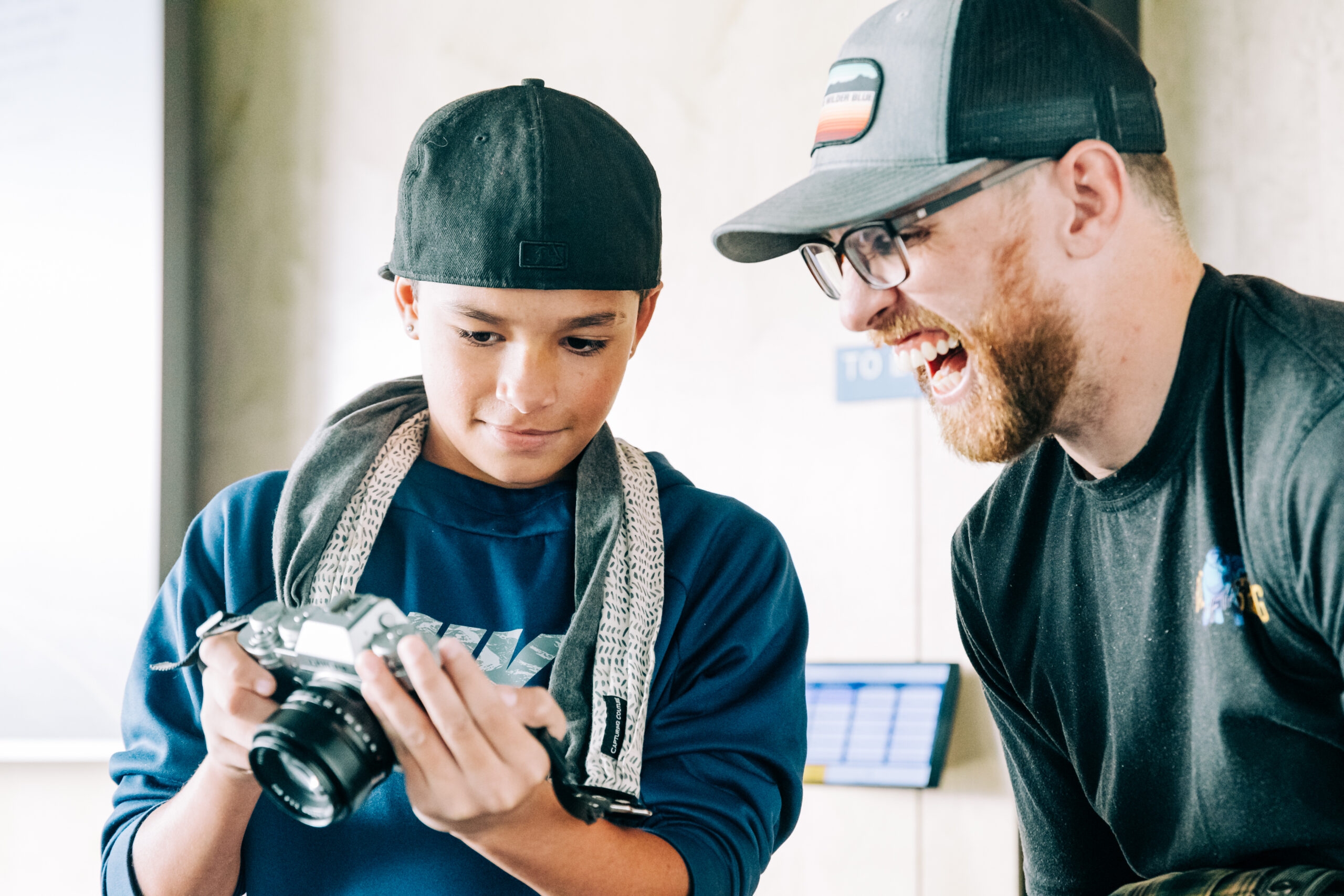
Suicide Loss Survivors
Grief support group.
The Suicide Loss Survivors Group is a twice-monthly peer-based grief support group for adults who have experienced the pain of losing someone to suicide death. Whether you are grieving the loss of a family member, friend, coworker, or other relationship, and regardless of how much time has passed since their death by suicide, you are welcome to attend this group.
When: 2nd and 4th Wednesday of each month.
Time: 6:30-8pm CST
The Collective for Hope (admin building)
8000 Chicago Street, Omaha, NE 68114
email questions to: [email protected]
Spanish Language Grief Support
This service is designed to provide resources and support for Spanish speaking individuals / families grieving a death loss. Interested agencies and individuals are encouraged to inquire by telephone
402-507-0190 (en Espanol)
402-502-2773 (English)
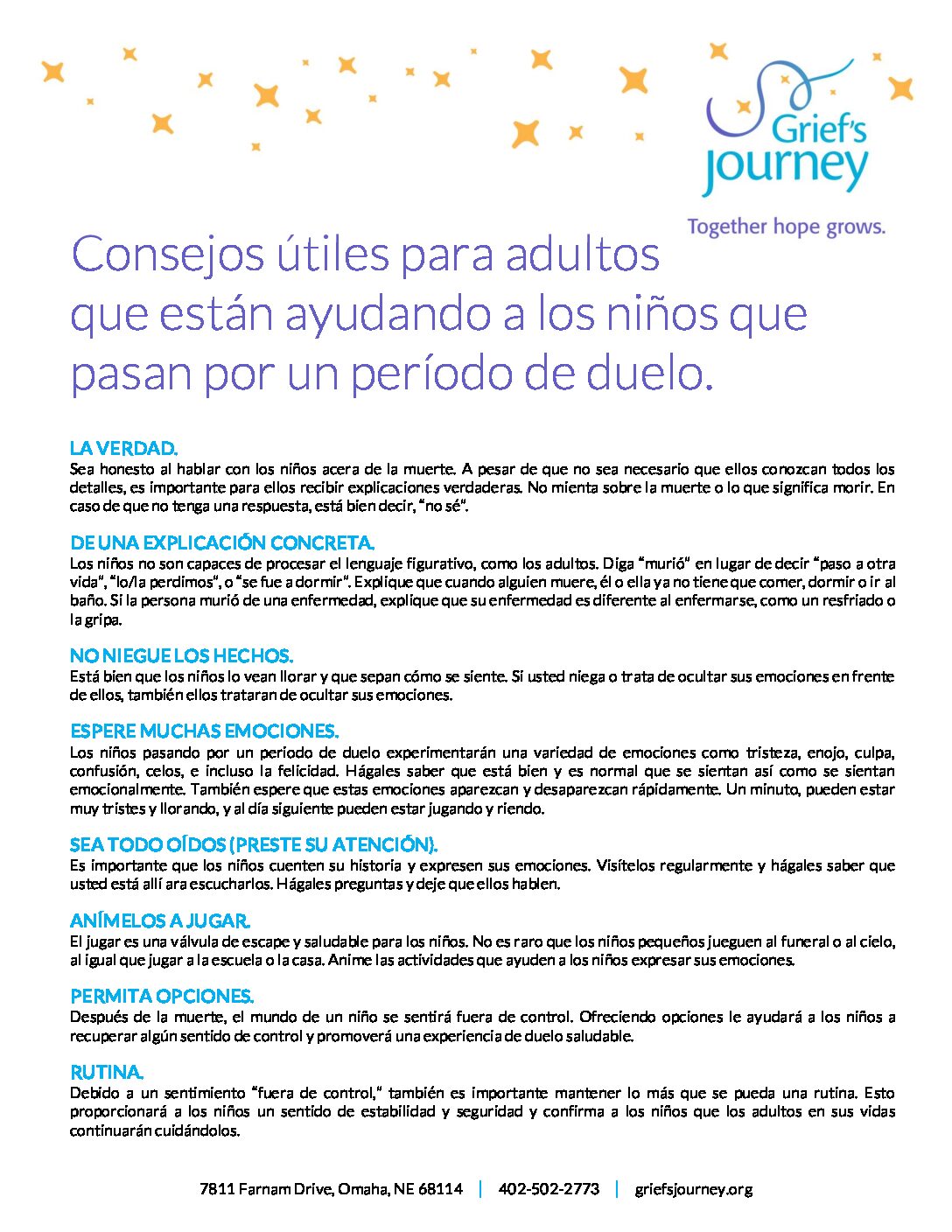
“Week after week, my daughter and I came back, and the support group was the best part of our week. I did my best to open up myself and my grief to the group, and in turn I felt myself growing. Over in the pre-teen group, my daughter was actually “having fun”. Let me say that again: My child had fun at a grief support group. She found a precious outlet to voice her grief and she met people her age who understood, and I’m so thankful for that. I have gained so much from this experience, and I think I understand now what moving forward looks like.”

Here’s the way I found support in my journey through grief
Editor’s note: Runner and writer Emily Halnon’s new book, “ To the Gorge: Running, Grief, and Resilience & 460 Miles on the Pacific Crest Trail ,” was released on May 7.
When my mom died, I spent a lot of time trying to stuff away my grief. Like, cramming another pile of bills into the junk drawer, so no one could see the mess inside.
I went to a friend’s house for dinner a month after her funeral. I hovered on the outskirts of the evening. Snippets of conversation floated around me, but my brain was foggy with grief. I couldn’t quite grasp onto anything through the haze.
My gaze caught on a framed photo of my friend and her mom, snapped in front of a rose bush in Eugene, Oregon, their arms pulled tight around the other.
The picture reminded me of the last time my mom visited me in Oregon. She posted Facebook updates from all three of the airports between Vermont and Eugene. A photo of a book cracked open on her lap in Salt Lake City, a coffee cup next to her. “Three hours and 17 minutes until I see my girl.”
When I picked her up, she bounced through the terminal to get to me. We spent the weekend running along the Willamette River, visiting covered bridges in the foothills of the Cascades, finding the best pastries in a 50-mile radius. She raced a half-marathon. She was 64. I thought we had decades left together. A thousand more miles to run.
The memories unleashed a rush of grief. I walked to the bathroom at my friend’s house as fast as I could, trying to conceal why I needed an escape route. My throat tightened. My eyes grew glassy with tears.
I slid into the bathroom, sat on the lid of the toilet and shoved a handful of toilet paper into my eyes. An ache gnawed at my heart. I pictured my friend and her mom. I thought about all the years and visits and miles I had lost with my mom. I swallowed back a sob, aware of the thin door between me and a room full of laughing people.
It was a familiar move. One I pulled at work, at the climbing gym, in the line at the brewery on the north side of town. I tried to hide my grief, so others didn’t have to see it. I bit my lip and pinched my eyes when I felt a wave of tears coming on. I pretended I was OK when I was anything but. I learned to almost never provide an honest answer to the question, “How are you doing?”
My grief made people uneasy
My mom had been sick with a rare uterine cancer for 13 months before she died. I’d already been the Sad Girl for too long. I felt the ways it was uncomfortable for people to be too close to my hardest emotions. And the ways society wanted me to grieve in isolation and to accelerate my journey through loss.
I’d faced many uncomfortable silences and quick goodbyes when someone wanted their own escape route away from me. I’d had friendships fade over the last 14 months and watched coworkers avoid my cubicle when I got back from any trip to Vermont.
A relationship ended when my then-boyfriend didn’t want anything to do with my emotional reality.
“I just don’t think you’re being positive enough,” he said after my mom was diagnosed with an aggressive, late-stage cancer. I’d just learned my mother would probably die within a year. Positivity felt like it was on another planet.
When my mom died in January 2020, I felt moved to do something to celebrate her life and her bold and brave spirit. She’d run her first marathon at 50. She learned how to swim when she turned 60, so she could do her first triathlon. She jumped out of a plane that same year to celebrate her birthday. And she lived through her 13 months of cancer with extraordinary courage and joy.
My mother felt the weight of cancer, but she insisted on continuing to live in her wholehearted way. She walked the dirt roads around her house in Vermont nearly every day she was sick, even through the harsh side effects of chemotherapy. She’d text me and tell me about the friends who joined her and how blue the sky was over the rolling hills.
“It’s what keeps me going,” she said.
Running in my mother’s honor
I decided to run the 460-mile section of the Pacific Crest Trail that crosses Oregon —and to try and do it faster than any human before me. My mom was every reason I was a runner because I watched her run that first marathon and felt wildly inspired to do one myself. I got hooked on exploring my limits through running and kept going.
Doing a big run in her honor felt like an obvious path to take through the upheaval of her death. But when I started training for it, I wondered if it was a terrible idea to attempt such a huge run while trudging through the heaviest grief.
On one of my first days of training, I went through the motions to get ready. Every move was weighed down by grief. I laced my shoes like my fingers were dragging through molasses. I walked out the door like I was wading through mud, questioning my decision.
I headed to the wooded hills behind my house. When I stepped onto the soft dirt that weaves through the pine trees, I exhaled. My breath flowed through me like a river, finally escaping the logjam that’d kept it wound tight inside me.
The soft dirt cradled my footsteps as I ran. A breeze rustled pine needles and wrapped around me. I remembered bringing my mom to this trail and felt a hot tear roll down my cheek and fall to the earth below. The fierce longing for her was lockstep with me on the trail.
As I ran, I thought about that first marathon I did with my mom.
I had gone out way too fast and hit a wall of fatigue about halfway through the race, where I felt like I couldn’t keep going. As I struggled, I saw my mom bounce past around mile 14 — and I was amazed that her stride was strong and confident.
I called to her, “Mommmmm!” like I was 5 years old again and wailing for my mother. But the race was too crowded for her to hear me.
I cried again, “Mommmm!”
I made no attempt to hide how I was feeling in that moment. Very few people do, while running a marathon, or any long distance on the roads or trails. If you stand on the sides of a marathon course, you’ll see the rawest human emotions on display.
It’s one of the things I love most about running.
No hiding your grief when running
Like, in a 100-mile race, you’re pretty much guaranteed to hit a low. Almost no one makes it to the finish line without getting slapped with something rough: debilitating self-doubt, obliterated muscles, a sour stomach, crushing overwhelm.
And when that happens, we don’t run to the bathroom to hide our feelings behind a closed door. We confront those lows in front of our fellow runners, our friends, the volunteers, the spectators.
When I bonked at mile 40 of my first 100-mile run, I told members of my crew, “I’m having a hard time right now,” and they didn’t flinch in the face of my struggle. They helped me into a camp chair, brought me slices of quesadilla and stayed by my side. They held space for me to work through my low.
When we stand on the start line of a marathon or a 100-mile race, we embrace the vulnerability that goes with the distance. We know it might get hard. We know we might turn into a running billboard, advertising our toughest moments. And we run straight into that reality. We promise the humans standing alongside us that we’ll bear witness to what they endure and not turn away from them.
There are so few spaces that invite that kind of emotional honesty — and create space for it.
Pressure not to feel grief
I got five days of bereavement at work. In this culture, there’s an expiration date on our time as the Sad Girl, in the company of anyone but our closest friends and family. There’s pressure to travel quickly from the center of Griefville to the streets of perfectly OK. Even though I am not.
On the trail, I am free to feel my feelings. When I step into the woods, I’m like a snake shedding my skin, leaving a more tender part of me exposed. I can let my guard down and allow my rawest emotions to bubble to the surface.
I was worried the Pacific Crest Trail run would be too much. But as I kept training, I discovered that running was one of the best places to process my grief. I could move through my sorrow, instead of swallowing it back and trapping it inside me. Running gave me something I desperately needed after losing my mom. Something that’s way harder to find than it should be.
Running gave me a place where I didn’t have to stuff anything away, where I could let my love for my mother and my grief over losing her far too soon unfold with the miles and take up as much space as the ground beneath my feet and the wide, open sky above.
Sign up for CNN’s Stress, But Less newsletter. Our six-part mindfulness guide will inform and inspire you to reduce stress while learning how to harness it .
For more CNN news and newsletters create an account at CNN.com


Choose Your Journey
Choose your resources.

When You Are Grieving

Helping a Grieving Person

Watch Dr. Bill's Video Series

Read Dr. Bill's Articles
Meet dr. bill.
Dr Bill Webster is someone who knows about grief, not just in theory, but from a very difficult personal experience.

About the Centre
The Centre for the Grief Journey was established in 1992 to assist and support people in a grieving process after a significant loss and to provide meaningful resources and helps.

ebooks (PDF Downloadable)
Physical Books
Grief Care Packages

Understanding Grief
Every time we experience a loss, we grieve what is missing from our lives as a result. Death, as we have said, is not the only loss to trigger grief. We have been feeling grief over these weeks even though we may not have recognized it as such. It is very important to understand, however, that there is no one neat orderly way to understand the grief process. It is not “5 Stages” or any other “one size fits all” formula.
So we need to begin by understanding what grief is. In simple terms, grief is a natural human response to an unwelcome event. It is defined as “ a natural human reaction to any significant loss, manifesting itself in a unique cluster of human emotions, intensified and complicated by the relationship we have lost.”
Unfortunately, in our “death denying culture”, we are not taught what to expect in the days and months after a loss, and so grief inevitably catches us by surprise. Often a few weeks or months down the road we can feel like it is getting even worse. In fact, sometimes it is when others think we should be getting ourselves together, that the grieving person feels like they are falling apart. When people find themselves unavoidably confronted with loss and struggling with grief, it can be one of life’s most challenging experiences, and often we need help to come to terms with it.
a) Grief is a Natural Human Experience
Our definition above affirms my conviction that grief is a “normal reaction to an unwelcome event.” It is not a sickness or disease, nor should it be considered a mental health disorder. Grief is a natural, human response to any significant loss.
However, the fact that it is normal does not diminish how difficult the experience can be. We should “normalize” but not “minimize.” What many people are going through as a result of this pandemic and the subsequent life losses they have incurred must never be underestimated.
When you lose someone or something special from your life, whether by death, disease, distance, or disaster, you are going to grieve. Grief is our protest against something we don’t like or want. Our grief is saying that we’re struggling to adjust to a life without that special relationship.
By understanding what you can expect, you are able to validate the experience of grief. When you have legitimized the process, you feel able to “work through” the unique issues your specific loss raises, knowing you are not crazy or abnormal. You realize that your grief is not a reflection on the “inadequacy of your coping skills”; it is an indication that you are missing something or someone you cared about.
When liberated from the stigma of grief, which is the fruit of those “pull yourself together and get over it” statements people make, you can begin the grief journey of exploring your feelings about how your world has changed and making the adjustments you need to reorganize your life.
b) Grief is a Uniquely Personal Experience
Every individual is unique. We are all different, in looks, in character, in cultural diversity, as well as in human experiences. While there may be many similarities, every individual manifests grief in a way that is appropriate for them. That is influenced and shaped by many variables: what we have lost and how; anticipated or sudden/unexpected loss; our age and our gender; our beliefs and values; our cultural context and traditions, among others.
Here is the dilemma we face in supporting people through this pandemic. Some are welcoming the pause and the opportunity to reconnect with themselves and their family. They have an opportunity to do the things that they had long promise they would get to “one of these days”.
But for others, this has been a living hell, isolated in homes where relationships are strained and possibly even finding themselves in unsafe situations, facing financial pressures, unemployment, or facing not being able to visit elderly or sick loved ones in nursing homes, or being present with them when they are dying. Many are overwhelmed by the hierarchy of needs that daily demands their attention, and finding ways to cope.
But for most people, their experience is a combination of all of the above.
Grief is always a struggle. It is never easy to lose someone or something you have relied on. This is possibly the most difficult experience of life.
But as we struggle, we discover that in every loss there is a gain. There will be times when you will wonder if they can make it, but little by little you will that in the struggle you find strength you didn’t know you had.
In our next blog we will seek to understand something more about this experience of grief which I think you will find interesting.
Life in Difficult Times Topics:
Privacy | Legal | Credits
Copyright 2003 - 2023 - The Centre for the Grief Journey
83 episodes
Your Grief Story is important. Share it with others. Encourage one another. Each of our episodes explore a specific type of loss that is unique and important. Guests openly share their personal stories.
It's All About the Story: Personal Grief Stories Rick Bergh
- 23 APR 2024
The Grief Journey of a Mom and Her Three Young Children
The Grief Journey of a Mom and Her Three Young Children Nikki Paul openly shares her grief journey following the traumatic death of her husband as result of a vehicle accident. As a pediatrician, Dr. Nikki learns new lessons and skills in the midst of her deep grief, working through a new chapter as a single mom with three young children. Find hope in Niki’s story and her renewed sense of purpose as she encourages other moms in her role as a grief coach who has experienced loss herself. [email protected]
- 24 MAR 2024
Awkward Moments at the Water Cooler: Engaging a griever returning to work
It’s happened to many of us – we return to work following the death of a loved one. We’re anxious. Our co-workers are afraid to say or do the wrong thing. Suzanne Jobour returned to work with trepidation following the death of her son, Ben. She now shares her experience openly – her grief journey resulted in a mission to help change grief in the workplace, one organization at a time. Suzanne Jabour (she/her) https://SuzanneJabour.com Grief Educator for business leaders who want to address grief in the workplace to save money and boost retention, engagement and productivity.
- 22 FEB 2024
Equine Assisted Therapy: What a horse can offer in a grief journey
Becky Cort combines two passions in her profession of caring for those who are experiencing loss: her compassion for people and her love of horses. Learn about the fascinating world of Equine Assistant Therapy, and the role a horse can play with its ability to create a non-judgmental space for those who are on a grief journey. [email protected]
Leaving on a Jet Plane..... And finding a grief friend
Lisa and Monica first met on a flight from Las Vegas to Calgary. Little did they know that they would become best friends because of their common grief journey - both had experienced the death of a parent. Hear about their first encounter, the lessons they've learned from each since then, and their ongoing long-distance friendship as they continue to support each other in their grief across the miles. You'll be encouraged and challenged as you hear their amazing and unique story.
- 25 JAN 2024
The Foods We Eat – Part 2 Nutritional options for sleep & brain health
Holistic nutrition professional and Red Seal chef, Jenna Den Hoed, joins us for a second episode about nutrition and health. Jen will help us reflect upon the foods we purchase and eat. She’ll also take a deep dive into understanding foods that help us sleep better and support brain health. Why not begin 2024 by examining the foods you ingest and by discovering how to change your eating habits so you can find energy and enjoy life to the max? https://jenourish.ca/ Book a free discovery call with Jenna
- 10 JAN 2024
Food, Stress and Health – Part 1: Holistic wisdom about the foods we eat
Holistic nutrition professional and Red Seal chef, Jenna Den Hoed, takes us into the fascinating world of foods for healthy living. In this episode you will receive a wealth of information about why your body works the way it does and why certain foods help you to thrive as you nourish body, mind, and soul. You will learn about stress and food, gaining information from current research that will answer many of your food choice questions. You’ll also hear Jenna’s personal story as she was diagnosed with celiac disease at seven years of age. This in turn led to her passion of helping people understand food choices for their ongoing health and happiness. https://jenourish.ca/ Book a free discovery call with Jenna
- © 2024 It's All About the Story: Personal Grief Stories
Top Podcasts In Education
You might also like.

- Death & Grief

Enjoy fast, free delivery, exclusive deals, and award-winning movies & TV shows with Prime Try Prime and start saving today with fast, free delivery
Amazon Prime includes:
Fast, FREE Delivery is available to Prime members. To join, select "Try Amazon Prime and start saving today with Fast, FREE Delivery" below the Add to Cart button.
- Cardmembers earn 5% Back at Amazon.com with a Prime Credit Card.
- Unlimited Free Two-Day Delivery
- Streaming of thousands of movies and TV shows with limited ads on Prime Video.
- A Kindle book to borrow for free each month - with no due dates
- Listen to over 2 million songs and hundreds of playlists
- Unlimited photo storage with anywhere access
Important: Your credit card will NOT be charged when you start your free trial or if you cancel during the trial period. If you're happy with Amazon Prime, do nothing. At the end of the free trial, your membership will automatically upgrade to a monthly membership.

Download the free Kindle app and start reading Kindle books instantly on your smartphone, tablet, or computer - no Kindle device required .
Read instantly on your browser with Kindle for Web.
Using your mobile phone camera - scan the code below and download the Kindle app.

Image Unavailable

- To view this video download Flash Player

JOURNEY THROUGH GRIEF: Honoring Beloved Pets And Beyond Hardcover – April 16, 2024
Purchase options and add-ons.
- Print length 77 pages
- Language English
- Publication date April 16, 2024
- Dimensions 6 x 0.37 x 9 inches
- ISBN-13 979-8323114917
- See all details

Product details
- ASIN : B0D1XRLJFM
- Publisher : Independently published (April 16, 2024)
- Language : English
- Hardcover : 77 pages
- ISBN-13 : 979-8323114917
- Item Weight : 6.1 ounces
- Dimensions : 6 x 0.37 x 9 inches
- #751 in Pet Loss Grief
- #7,979 in Love & Loss
- #12,819 in Children's Dog Books (Books)
Customer reviews
Customer Reviews, including Product Star Ratings help customers to learn more about the product and decide whether it is the right product for them.
To calculate the overall star rating and percentage breakdown by star, we don’t use a simple average. Instead, our system considers things like how recent a review is and if the reviewer bought the item on Amazon. It also analyzed reviews to verify trustworthiness.
- Sort reviews by Top reviews Most recent Top reviews
Top reviews from the United States
There was a problem filtering reviews right now. please try again later..
- Amazon Newsletter
- About Amazon
- Accessibility
- Sustainability
- Press Center
- Investor Relations
- Amazon Devices
- Amazon Science
- Sell on Amazon
- Sell apps on Amazon
- Supply to Amazon
- Protect & Build Your Brand
- Become an Affiliate
- Become a Delivery Driver
- Start a Package Delivery Business
- Advertise Your Products
- Self-Publish with Us
- Become an Amazon Hub Partner
- › See More Ways to Make Money
- Amazon Visa
- Amazon Store Card
- Amazon Secured Card
- Amazon Business Card
- Shop with Points
- Credit Card Marketplace
- Reload Your Balance
- Amazon Currency Converter
- Your Account
- Your Orders
- Shipping Rates & Policies
- Amazon Prime
- Returns & Replacements
- Manage Your Content and Devices
- Recalls and Product Safety Alerts
- Conditions of Use
- Privacy Notice
- Consumer Health Data Privacy Disclosure
- Your Ads Privacy Choices

IMAGES
COMMENTS
Thank you for visiting Griefjourney.com. We hope you've found support and comfort and we hope you stay in touch through our social media channels. Executive Director. The Centre for the Grief Journey. Griefjourney.com, created by Dr. Bill Webster, has been providing the most comprehensive online grief support for nearly 20 years.
Some prefer to represent grief as a cyclical process, where the grieving individual repeats phases multiple times on a gradual journey to recovery. The dual process model of grief (Stroebe & Schut, 1999) is an example of a cyclical model, in which the grieving individual oscillates between two processes of grief.
Introduction to the Grief Journey. This is an introduction to the concept of a grief journey as we look at the common phases even though everyone's journey is personal and unique. Healing through grief involves a personal journey. After guiding many individuals and families following the painful losses of loved ones, we know that those who ...
Grief is what you think and feel on the inside after someone you love dies. Mourning is the outward expression of those thoughts and feelings. To mourn is to be an active participant in our grief journeys. We all grieve when someone we love dies, but if we are to heal, we must also mourn. There are six "yield signs" you are likely to ...
Dr. Timothy Sumerlin 's The Grief Journey: Finding Peace in All of Life's Losses explores the remarkable restorative healing power of Jesus Christ in times of loss.The Grief Journey focuses on helping participants through their grief recovery journey in a safe and confidential group setting. Rather than avoiding grief, as so many of us are prone to do, this Book helps us take a hard look at ...
The Journey Through Grief. Facing our grief over the loss of a loved one can seem like a frightening journey into a foreign land of dark corners and scary terrain. We may wonder how we will survive the days ahead. Metaphorically, we might view the first days of shock and sorrow as walking on a barely lit unfamiliar road.
In Grief Is a Journey, Dr. Doka, a professor of Gerontology at the Graduate School of the College of New Rochelle, an ordained Luther minister, and the editor of Omega: Journal of Death and Dying ...
January 31, 2017Author: Elizabeth Harper Neeld. We often speak of the time following loss as a journey, yet it is not a journey anyone chooses and there are few guideposts along the way. In this section, author and suicide loss survivor, Elizabeth Harper Neeld outlines experiences commonly felt at different points in the journey.
Grief Is a Journey is the first book to overturn prevailing, often judgmental, ideas about grief and replace them with a hopeful, inclusive, personalized, and research-backed approach. New science and studies behind Dr. Doka's teaching upend the dominant but incorrect view that grief proceeds by stages.
The 5 Stages of Grief is a theory developed by psychiatrist Elisabeth Kübler-Ross. It suggests that we go through five distinct stages after the loss of a loved one. These stages are denial, anger, bargaining, depression, and finally acceptance.
Grief is a journey that doesn't come with GPS to let you know you exactly where you are and where you should be heading. And while each person's grief will be unique, our bereavement coordinators are available to help you maneuver through the difficult terrain ahead. We've created the following videos to help you better understand what ...
Providing rich media support for those coping with the loss of a loved one. Hosted by Dr. Bill Webster.
The Grief Journey. We are grateful to Elizabeth Harper Neeld for sharing excerpts from her book with the loss survivor community. Seven Choices: Finding Daylight After Loss Shatters Your World, is a classic in the field of grief literature. It was chosen by The American Red Cross to distribute to volunteers working with families of 9/11 and was ...
The Long Grief Journey is a great tool to have while experiencing grief or supporting others on their journey. The exercises/reflections throughout the book are validating and help in staying present with complicated feelings as they arise while moving through grief. Great book that can help anyone in any stage of grief!
Blog. Grief is often described as a journey - how poetic, right? Some days, we wonder why our grief can't just be as easy as taking a step outside to clear our heads and "get back on the horse". Remember that grief isn't just about becoming resilient in the face of loss and quickly finding a new normal, as though we are on a scavenger ...
Spanish Language Grief Support. This service is designed to provide resources and support for Spanish speaking individuals / families grieving a death loss. Interested agencies and individuals are encouraged to inquire by telephone. 402-507-0190 (en Espanol) [email protected]. 402-502-2773 (English)
The Bereavement Journey is a series of films and discussion groups that gently guide people bereaved at any time through the most common aspects of grief and bereavement, enabling them to process the implications for themselves and discern next steps. Usually run by churches, the programme uniquely offers a final session on faith questions in ...
Editor's note: Runner and writer Emily Halnon's new book, "To the Gorge: Running, Grief, and Resilience & 460 Miles on the Pacific Crest Trail," was released on May 7.
Editor's note: Runner and writer Emily Halnon's new book, "To the Gorge: Running, Grief, and Resilience & 460 Miles on the Pacific Crest Trail," was released on May 7. When my mom died, I ...
a) Grief is a Natural Human Experience. Our definition above affirms my conviction that grief is a "normal reaction to an unwelcome event.". It is not a sickness or disease, nor should it be considered a mental health disorder. Grief is a natural, human response to any significant loss. However, the fact that it is normal does not diminish ...
The Grief Journey of a Mom and Her Three Young Children Nikki Paul openly shares her grief journey following the traumatic death of her husband as result of a vehicle accident. As a pediatrician, Dr. Nikki learns new lessons and skills in the midst of her deep grief, working through a new chapter as a single mom with three young children.
Jocelyne Tranquilla didn't necessarily plan to work as the Bereavement Coordinator of the Palliative Care Service in Central Zone. In fact, she muses that she "hates hospitals," but it was through her natural career journey as a social worker where she often found herself working with clients, patients and loved ones at the intersection of grief and loss.I spent seven years working at ...
"Journey Through Grief" is a heartfelt testament to the enduring power of love, connection, and remembrance. It offers solace to those in mourning and serves as a beacon of hope for anyone embarking on the journey of healing. Whether you're currently navigating the depths of pet loss or seeking guidance through grief of any kind, this book is a ...
Here's the way I found support in my journey through grief Like, cramming another pile of bills into the junk drawer, so no one could see the mess inside. Posted 2024-05-07T15:49:12+00:00 ...